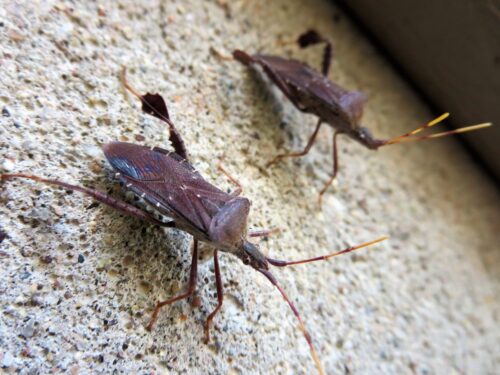“I don’t want to alarm you,” my husband said as he walked into my office. “But…”
If his plan was not to alarm me, it backfired. I immediately felt alarmed. And the situation was somewhat alarming, at least on the surface.

These bugs were all over the front of the house, hanging out on the foundation wall, massing on the siding, and clinging to the window screens. But my state of alarm was short-lived, because I was pretty sure that they were harmless. A quick Internet search confirmed that they were leaf-footed bugs and, based on their general appearance, most likely western conifer seed bugs. Gathering on houses in the fall is normal behavior for them, and we should probably be thankful that there weren’t more.
Usually when a local plant or critter has a geographical adjective in their name, it’s “northern” or “eastern,” so what are these westerners, native to the Pacific Coast, doing here in New England? They are expanding their range, according to Wikipedia, and they’re doing a good job of it. In the U.S. they’re considered to be minor tree pests, except where pine trees are grown for commercial purposes. The bugs in our yard probably feed on the cones of the Eastern white pine, which grows abundantly in this area. But, these suckers can be found all over the globe now, including places where they are considered to be both invasive and harmful.
We didn’t need another tree pest, that’s for sure, but I’m relieved that these bugs are not kissing bugs. Their resemblance to kissing bugs was what had had my husband concerned. That’s a common reaction. Years ago, when we first started finding these bugs in the house occasionally, I looked them up because I was similarly concerned. At the time, I thought that they were assassin bugs (related to kissing bugs) but definitely not kissing bugs, because kissing bugs didn’t live this far north.
That’s not quite as safe of an assumption now, as I discovered when I researched the subject again this week. Kissing bugs, too, have expanded their range. They have been found in more than half of the 50 U.S. states. But they are not found in Rhode Island, at least not yet.
The resemblance of western conifer seed bugs to kissing bugs and also to assassin bugs has led to some confusion over whether or not they bite. Kissing bugs do, and they can give you Chagas disease. Assassin bugs do, and the bites are said to be painful. Western conifer seed bugs do not, and they don’t carry diseases. The worst they can do is make a stink (literally) and try to bite you, which won’t hurt much because their mouths really aren’t designed for biting. They don’t infest homes per se, but they do like to overwinter inside houses. So, the reason that they were all over the house is that they were looking for places to hide out for the winter. Understandable. We like to be inside for the winter, too.
Every year brings its own special buggapalooza. Last year was springtails. This year it’s western conifer seedbugs. There’s a lesson in this, one we’ve had to keep learning again and again–you want to live in the woods, you have to live with the bugs. The best you can hope for is that the bugs will be harmless, or at least relatively harmless, as this bug seems to be. I’ll take it over the spotted lanternfly any day.
